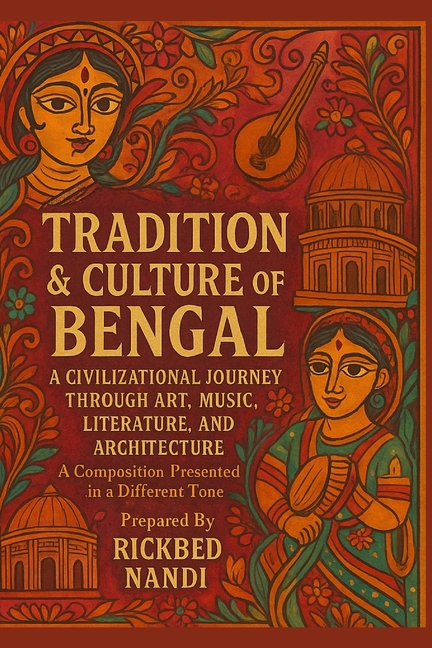Description
A Note to the Reader
This book is not a chronicle. It is not merely a collection of regional facts, architectural inventories, or folkloric catalogues. Rather, it is an attempt to walk the spiraling paths that the culture of Bengal has carved across time-paths that twist and return, overlap and vanish, and yet remain etched in the collective consciousness of its people.
If you, dear reader, have come expecting neat conclusions or linear timelines, I invite you instead into a landscape where terracotta temples echo the verses of vanished mystics, where dialects carry buried kingdoms, and where music resists notation in favor of embodied improvisation. This is not a Bengal of monoliths, but of textures-textiles and temples, river songs and resistance chants, oral verse and stone chisel.
This book moves between the scholarly and the experiential, between the architectural column and the sonic vibration. It is a portrait not only of Bengal, but also of a worldview: one that accepts multiplicity, lives with contradiction, and honors the invisible alongside the visible.
Let these pages be read not for mastery, but for encounter. May you meet voices here-not just mine-but those of riverbank minstrels, clay figurines, old scrolls, lost ghazals, and temple shadows. May the questions this book raises continue long after the final chapter ends.
This book is not a chronicle. It is not merely a collection of regional facts, architectural inventories, or folkloric catalogues. Rather, it is an attempt to walk the spiraling paths that the culture of Bengal has carved across time-paths that twist and return, overlap and vanish, and yet remain etched in the collective consciousness of its people.
If you, dear reader, have come expecting neat conclusions or linear timelines, I invite you instead into a landscape where terracotta temples echo the verses of vanished mystics, where dialects carry buried kingdoms, and where music resists notation in favor of embodied improvisation. This is not a Bengal of monoliths, but of textures-textiles and temples, river songs and resistance chants, oral verse and stone chisel.
This book moves between the scholarly and the experiential, between the architectural column and the sonic vibration. It is a portrait not only of Bengal, but also of a worldview: one that accepts multiplicity, lives with contradiction, and honors the invisible alongside the visible.
Let these pages be read not for mastery, but for encounter. May you meet voices here-not just mine-but those of riverbank minstrels, clay figurines, old scrolls, lost ghazals, and temple shadows. May the questions this book raises continue long after the final chapter ends.
Last updated on
Product Details
- Jun 8, 2025 Pub Date:
- 9798287350208 ISBN-10:
- 9798287350208 ISBN-13:
- English Language




